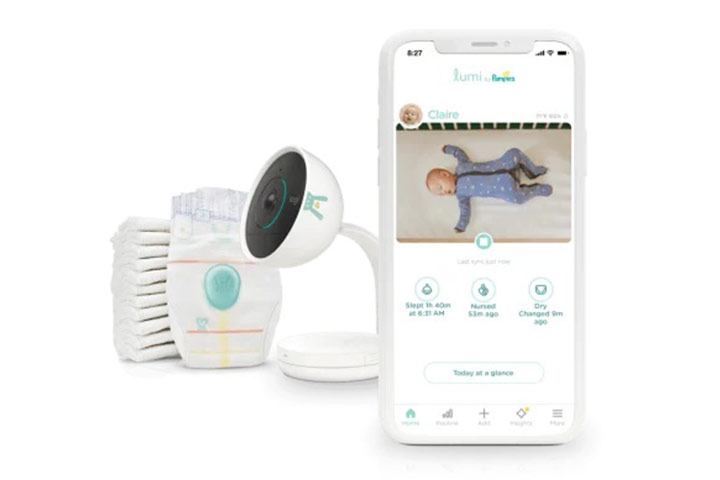Why Does My Baby Wild Out Before Sleeping
Knowing almost safe sleeping positions for babies is important in ensuring a prophylactic sleep environment and preventing the risk of sudden baby death syndrome (SIDS). SIDS falls under the category of sudden unexpected death in infancy (SUDI) and is majorly linked to the position in which the baby sleeps. Thus, knowing what positions are safe for your baby to slumber in is important to assistance prevent unexpected situations. As well, knowing a few tips that will help reduce the gamble of SIDS helps get a long way (1). 1 example of such a position of safe sleeping in babies is the supine position, in which the baby, who is less than a year old, is made to slumber on their back. Read on to know more about safe sleeping positions for babies and tips on slumber safe.
The Skillful And Bad Positions For A Baby To Sleep
It is essential to acquire nigh the safe and unsafe sleeping positions for a baby to deal with the above risks (2).
one. Sleep on dorsum
Healthy babies born full-term should be placed on their backs for naps, short periods of rest, and sleep at night.
- 'Sleep on the back' position was found to lessen the risk of SIDS in babies, equally it keeps airways open.
- The US National Constitute of Child Health and Human Development (NICHD) labeled this every bit the best sleeping position for babies (3).
- Since the American University of Pediatrics fabricated the 'back-to-sleep' recommendation in 1992, the SIDS rate has dropped more than 50%. The 'dorsum-to-sleep' recommendation was later campaigned as 'prophylactic to sleep' (four).
Risks Involved In 'Sleep On Dorsum' Position
If infants are placed on the back for a long fourth dimension, information technology may lead to 'positional plagiocephaly,' a case of flattened or misshapen head and 'brachycephaly,' the flattening of the back of the skull. The shape will become normal by the fourth dimension they plow one yr and rarely requires any treatment Simple repositioning techniques may exist employed to avoid such conditions. They include:
- Increasing 'tummy time' of the infant when awake
- Making the infant residuum on the other side of the head rather than the flat side.
- Cutting downward the fourth dimension spent by babies in carriers or car-seats.
- Getting more 'cuddle time'.
- Irresolute the direction of the baby in the crib so that they exercise not always view the same things, and in i direction always.
ii. Slumber on stomach
Several theories discourage parents from making a baby sleep on the stomach because:
- It could put pressure level on a baby'southward jaw, reducing the airway and restricting breath.
- If the baby sleeps on the stomach, i.e., in the prone position, they may be lying with the face very close to the sheets and breathing the same air.
- The baby may suffocate while sleeping on the tum if the mattress is very soft.
- The infant may also breathe in microbes nowadays on the mattress.
When Can Babies Slumber On Stomach?
In rare cases, due to a medical status, doctors may advise parents to make the baby sleep on the stomach rather than the dorsum.
- A few physicians believe that sleeping on the stomach could be proficient for babies with severe gastroesophageal reflux or certain upper-airway malformations like Pierre Robin Syndrome, which pb to astute airway obstacle episodes. Nonetheless, no recent written report supported or refuted the benefits. Healthcare providers should consider the potential benefits and risks earlier recommending this position.
- The danger of vomiting was the almost of import argument for making the baby sleep on its breadbasket. This is because doctors believed that it would be unsafe if the infant vomits while sleeping on the dorsum. They argued that babies might asphyxiate on their vomit, due to lack of enough strength to turn the head. Notwithstanding, babies sleeping on their backs may not have as much difficulty turning their heads and vomiting the contents of the tum out.
- Besides, you may brand a babe with colic sleep on the stomach to relieve them of gas. All the same, practice non practice it immediately afterward feeding them. Let there be some gap betwixt the feed and the sleep time.
3. Sleep on the side
It is unsafe for babies to slumber on the side because they may cease up on the stomach, increasing the take chances of SIDS.
In add-on to the good and bad sleeping positions, you must as well know about the sleeping practices that could pb to a sudden unexpected decease in infants.
Related Products
Pampers Lumi Baby Monitor

Sleeping Practices That Could Lead To Sudden Unexpected Decease In Infancy (SUDI)
SUDI includes both SIDS and other fatal sleeping accidents. Here are a few practices that could pb to SUDI:
- Making the baby sleep on the breadbasket or side.
- Putting the baby to sleep on soft surfaces such as mattress, sofa, waterbed, pillow, or lamb's wool, either with or without a parent around.
- Covering the babe'due south caput or confront with bedding, which may cause adventitious suffocation and overheat.
- Smoking during pregnancy or afterward childbirth.
SIDS can be a pregnant risk and should be considered when you follow certain steps to ensure that your baby sleeps safely.
11 Tips For Safety Babe Sleep
For babies who are healthy and under one year of historic period, sleeping on the back is the ideal position. However, some actress measures would exist helpful to ensure safe sleep for your baby (1).
- Avoid loose bedding: It is advisable to use a firm mattress rather than an overly soft mattress, waterbed, or sofa for your baby. Experts suggest confronting the usage of bumper pads, pillows, fluffy bedding or stuffed animals around the baby in the crib. In simple words, anything that could comprehend a infant's head or face during sleep is not recommended.
- Keep the crib simple: Do not use wedges, quilts, or comforters nether an infant in the crib. Let the infant sleep with the feet touching the lesser of the crib so that he can't wriggle down nether the bedding. Use a firm, clean mattress that fits the cot well and tuck in the bedclothes deeply. The sides or ends of the crib should be high enough to prevent the baby from climbing out or crawling out.
- Avoid covering the baby'south caput: Blankets should be covered only up to the chest of the infant with arms exposed, to avoid the shifting of the blanket onto the head and thereby preventing suffocation. The American Academy of Pediatrics recommends using 'sleep sack' or 'baby sleep bag' as a blazon of bedding to keep him warm without covering the head. Sleeping bags with a fitted neck and armholes and no hood are considered the safest. Wrapping a baby in lightweight cotton or muslin also helps in preventing him from rolling onto the tummy during sleep.
- Avoid overheating: Infants should exist clothed lightly for sleep. Avoid over-bundling and cheque if the infant is not hot to touch.
- Proficient sleep environs: It is important to maintain a considerably absurd sleeping environment with a temperature of around xxoC for the baby.
- Vaccination: An investigation washed on diphtheria-tetanus-pertussis immunization and potential SIDS association past the Berlin School of Public Health has concluded that increased DTP immunization coverage is associated with decreased SIDS bloodshed (5). Current recommendations on timely DTP immunization should be emphasized and followed to prevent not merely specific infectious diseases but besides potentially SIDS.
- Use a pacifier (at sleep times): The American Academy of Pediatrics considers pacifiers could prevent SIDS. However, exercise not force the baby if they do non want information technology or if information technology falls out of the mouth. If you are breastfeeding, expect until it is well established before showtime to apply a pacifier. It ordinarily takes around 3 to four weeks of age for the babe to get comfortable with breastfeeding.
- Use technology: If you lot are worried about the babe's sleeping position, especially when they are in a split up room, use Wi-Fi infant monitors, app-powered thermostats, or small alarms to monitor the sleep position also every bit vitals of your babe.
- Avoid use of products that merits to prevent or reduce SIDS. This is crucial equally scientifically, in that location is no known way to forestall SIDS. Prophylactic and efficacy of wedges, positioners, or other such products that claim to forestall SIDS are not proven. On the opposite, various incidents take been reported where these products have been associated with injury and expiry when used in the baby's sleep area (6).
- Share the same room: You lot may share the same room with the baby for user-friendly breastfeeding and contact. The crib in which the baby sleeps should be closer to parents.
- Avert sharing the bed: Experts propose that infants ideally should non share the bed with parents, adults, siblings, or other children. Twins or multiples may exist made to slumber separately. Do not share a bed with your baby, especially if y'all or your partner take been drinking, smoking, or taking medications or drugs that could induce deep slumber. Smoking and the use of a substance like drugs or alcohol significantly increment the take a chance of SIDS and suffocation in babies, if the bed is shared.
Frequently Asked Questions
1. What if the baby rolls onto the stomach while sleeping?
Around 4 to five months of age, babies begin to roll over onto their tummy from their back (7). This tin can be alright every bit the SIDS gamble generally lowers past this time. Let the baby notice a comfy sleeping position; they may be able to turn the face to the side to keep the mouth and nose free for breathing when sleeping on the stomach. In whatever case, ever place the infant on the back when you lot put them down on the bed to sleep.
Note that the SIDS take a chance is at a superlative between one and four months of age, but it remains a threat until babies are 12 months old. So, follow other precautions to reduce the chance of SIDS all through your baby'south first twelvemonth.
2. Why does my baby slumber in fencing reflex while in the dorsum-to-sleep position?
Babies exhibit many involuntary movements as they grow. 1 such move is the Fencing Reflex or Tonic Neck Reflex (eight). When placed on the back-to-sleep position, the baby's head turns to one side with the arm and leg of that side extended, while the other arm and leg are flexed. This is called the fencing position, which helps forbid a baby from rolling over onto the tum before the body is set up for it. This is i more reason for putting your baby to slumber on the back. This involuntary move will disappear anytime between three to half dozen months of age.
three. When can the baby be on its breadbasket?
The baby may be put on the breadbasket, but under supervision, when awake. Giving breadbasket fourth dimension for babies is a practiced style to strengthen their stomach, back, and neck muscles.
According to Dr. Karen Sokal-Gutierrez, clinical professor, community wellness and homo development, University of California Berkeley-UCSF Joint Medical Programme, SIDS risk is lowered with babies spending more than tummy time when they are awake (ix). Moreover, the baby would develop upper body strength needed to elevator the head and roll over in sleep.
4. Can I use infant slumber positioners for my baby?
There is no U.s.a. FDA blessing for infant sleep positioners to reduce or prevent the gamble of SIDS in babies.
5. What if babies throw upward when sleeping on the back?
There is a depression risk for healthy babies to asphyxiate on vomit when made to slumber on their backs than on their sides or tummies. Sleeping on the back does not increase choking gamble in babies with gastroesophageal reflux illness either. But do not put the baby to bed with a bottle propped for feeding. This exercise could pb to ear infections and choking.
6. What to do if my baby has difficulty sleeping on the back?
A few infants may not have a deep sleep in the back-to-slumber position. Some may even become fussy when placed on the back.
The baby may not feel comfortable sleeping on the back if they have a congested nose. In such a case, place a humidifier in the baby's room to moisten the air and loosen the congestion. Elevating the head slightly could minimize the discomfort from a stuffy olfactory organ.
7. What if my baby throws up while sleeping?
If your baby throws upwardly, turn their caput to the side. Make clean upward the vomit and change the bedding before you lot put the baby back to sleep again.
8. What are the best sleeping positions for preterm babies?
According to a inquiry report, preterm infants are at a college SIDS risk, and they are to be placed on the dorsum-to-sleep position (x). Still, in a highly monitored inpatient setting, sleep on stomach position may exist appropriate in case of acute respiratory disease in preterm infants.
Sleeping position is crucial to prevent the risk of SIDS in babies, particularly under 12 months of age. Whether information technology is a full-term or preterm infant, sleeping on the back is considered safe unless directed otherwise by a md due to some medical condition.
If you lot take whatsoever tips to ensure the safe of a baby while sleeping, do share with us in the comments department below.
References:
MomJunction'due south articles are written after analyzing the inquiry works of proficient authors and institutions. Our references consist of resources established by regime in their respective fields. You can larn more about the authenticity of the information we present in our editorial policy.
The following ii tabs alter content beneath.
- Reviewer
- Author

Dr. Rajeev Ranjan is a senior neonatologist and pediatrician at the Nidan Mother And Child Care Clinic in Noida, India. He completed his Medico from Tsma-Tver Medical University, Russia, in 2005, DCH from Dr. D. Y. Patil Medical College (Mumbai), and FCH, MCH (Delhi) in 2004. With 18 years of experience, Dr. Ranjan is a member of the Indian Medical... more

Swati Patwal is a clinical nutritionist and toddler mom with over viii years of experience in various fields of nutrition. She started her career as a CSR project coordinator for a salubrious eating and active lifestyle project catering to schoolhouse children. So she worked as a nutrition faculty and clinical diet jitney in different organizations. Her involvement in scientific writing... more
Why Does My Baby Wild Out Before Sleeping
Source: https://www.momjunction.com/articles/safe-sleeping-positions-for-babies-and-newborns_0094200/
